ECU MITSUBISHI ECLIPSE 1991 Workshop Manual
[x] Cancel search | Manufacturer: MITSUBISHI, Model Year: 1991, Model line: ECLIPSE, Model: MITSUBISHI ECLIPSE 1991Pages: 1216, PDF Size: 67.42 MB
Page 175 of 1216
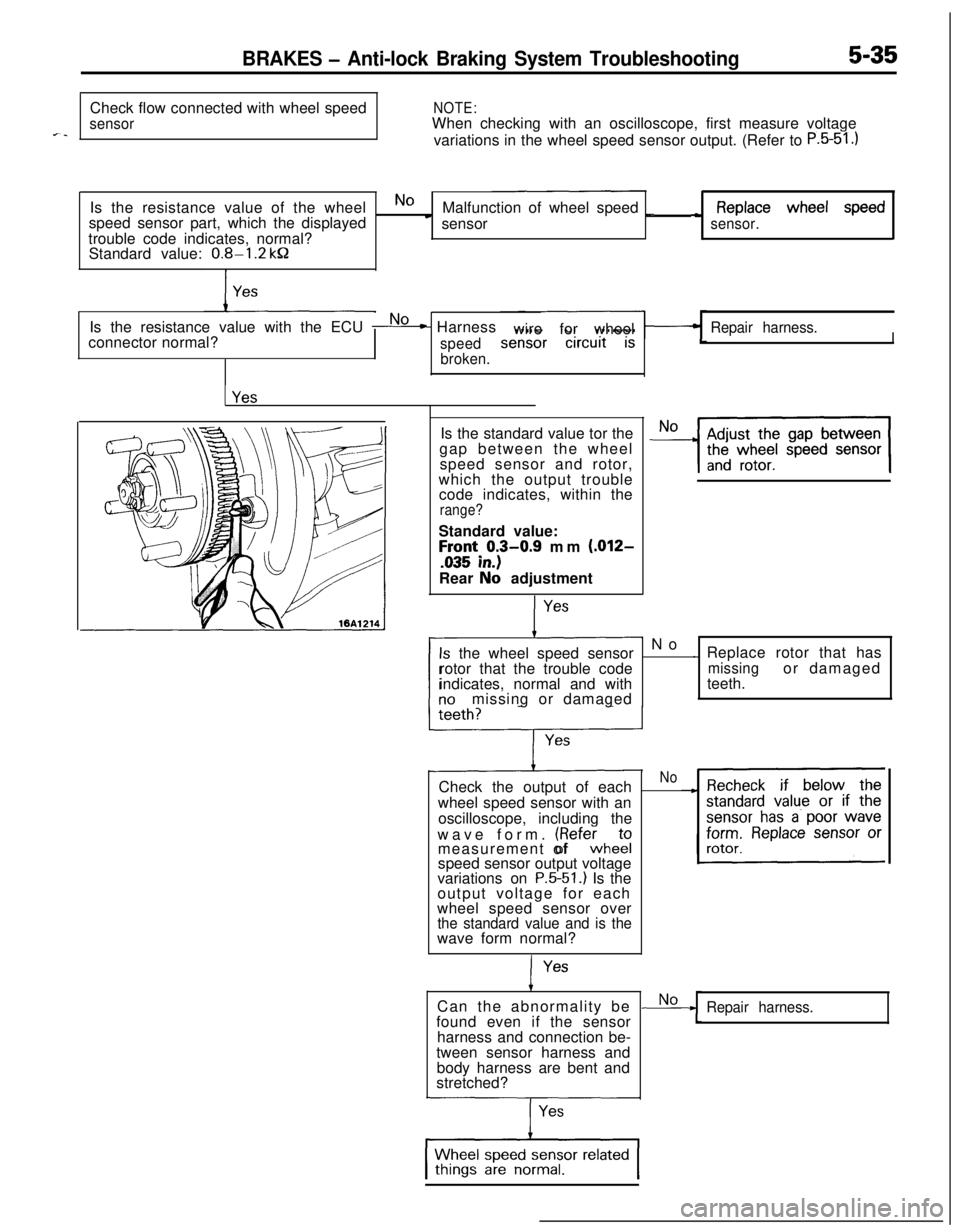
BRAKES - Anti-lock Braking System Troubleshooting5-35Check flow connected with wheel speed
NOTE:
sensorWhen checking with an oscilloscope, first measure voltagefl-variations in the wheel speed sensor output. (Refer to P.5-51.)Is the resistance value of the wheel
speed sensor part, which the displayed
No cMalfunction of wheel speed _~ Replacewheel speedsensor
sensor.trouble code indicates, normal?
Standard value:
0.8-l .2 kQIs the resistance value with the ECU
No* Harness
wireforwheelRepair harness.connector normal?
speedI
broken.Is the standard value tor the
gap between the wheel
speed sensor and rotor,
which the output trouble
code indicates, within the
range?Standard value:
h;ti;j3-0.9 mm (.012-Rear
Nb adjustment
- No
the wheel speed sensor. Replace rotor that has
rotor that the trouble code
missingor damaged
indicates, normal and withteeth.
missing or damaged
Check the output of each
wheel speed sensor with an
oscilloscope, including the
wave form.
(Refewhekqmeasurement of
speed sensor output voltage
variations on
P.5-51.) Is the
output voltage for each
wheel speed sensor over
the standard value and is thewave form normal?I
YesCan the abnormality be
found even if the sensor
harness and connection be-
tween sensor harness and
body harness are bent and
stretched?
No
Repair harness.
Page 176 of 1216
![MITSUBISHI ECLIPSE 1991 Workshop Manual 5-36BRAKES - Anti-lock Braking System Troubleshooting
E-3Abnormality of G sensor circuit
[Explanation]The ABS ECU turns on the warning light in the
following cases.
lOFF trouble turning G sensor OFF ( MITSUBISHI ECLIPSE 1991 Workshop Manual 5-36BRAKES - Anti-lock Braking System Troubleshooting
E-3Abnormality of G sensor circuit
[Explanation]The ABS ECU turns on the warning light in the
following cases.
lOFF trouble turning G sensor OFF (](/img/19/57104/w960_57104-175.png)
5-36BRAKES - Anti-lock Braking System Troubleshooting
E-3Abnormality of G sensor circuit
[Explanation]The ABS ECU turns on the warning light in the
following cases.
lOFF trouble turning G sensor OFF (It is judged
that the
G sensor continues to be OFF for more
than approximately 13 seconds except when the
lWhen there is a broken wire or short circuit in
the harness for the
G sensor system.
PlUN; F;SIBLEIGNITIONSWITCH (IG2)J/B
G-SENSOR
E-lABSECU
14AO609
Is G sensor normal? (ReferNoto
P.5-86.)Replace G sensor.
I YesWith the ignition key “ON”
_ No m The harness between the
does the voltage betweenG sensor and the ABS
terminal No.6 and groundECU is broken.
indicate battery voltage?
IG sensor circuit is normal.I
Page 177 of 1216
![MITSUBISHI ECLIPSE 1991 Workshop Manual BRAKES - Anti-lock Braking System Troubleshooting5-37
E-4Abnormality of stop light switch circuitI
- [Explanation][Hint]The ABS ECU turns on the warning light in theIf the stop light operates normal, MITSUBISHI ECLIPSE 1991 Workshop Manual BRAKES - Anti-lock Braking System Troubleshooting5-37
E-4Abnormality of stop light switch circuitI
- [Explanation][Hint]The ABS ECU turns on the warning light in theIf the stop light operates normal,](/img/19/57104/w960_57104-176.png)
BRAKES - Anti-lock Braking System Troubleshooting5-37
E-4Abnormality of stop light switch circuitI
- [Explanation][Hint]The ABS ECU turns on the warning light in theIf the stop light operates normal, the ABS harness
following cases.
wire for the stop light switch input circuit to the ECU
lStop light switch may remain on for more thanis broken or there is a malfunction in the ABS ECU.
15 minutes without the ABS functions.
lThe harness wire for the stop light switch may
be open.
AUTO-CRUISE
STOP
--I0.85-G
’LIGHT
w
STOPLIGHTSWITCHABSECURESIS-
TOR
14AO610
Do the stop lights light up _ No c Check the stop light re-and go out normally?lated circuit and repair
problem spots.
Yes
isconnect the ABS ECconnector and inspect at
the harness side
connec-
tor.When the brake pedal is
NoHarness wire between
pressed forcefully, does the
* stop light switch and ABS
voltage between connectorECU is broken.
terminal No. 29 and ground
indicate battery voltage?
c
Repair harness.
Yes.
;gSJ;ght switch circuit is
Page 178 of 1216
![MITSUBISHI ECLIPSE 1991 Workshop Manual 5-38BRAKES - Anti-lock Braking System Troubleshooting
E-5Abnormality of solenoid valve drive circuit
[Explanation]*>The ABS ECU normally monitors the solenoid valve
when turned OFF, the ECU determines MITSUBISHI ECLIPSE 1991 Workshop Manual 5-38BRAKES - Anti-lock Braking System Troubleshooting
E-5Abnormality of solenoid valve drive circuit
[Explanation]*>The ABS ECU normally monitors the solenoid valve
when turned OFF, the ECU determines](/img/19/57104/w960_57104-177.png)
5-38BRAKES - Anti-lock Braking System Troubleshooting
E-5Abnormality of solenoid valve drive circuit
[Explanation]*>The ABS ECU normally monitors the solenoid valve
when turned OFF, the ECU determines the solenoid%’ -’drive circuit.coil wire is broken/short circuited or the harness is
If no current flows in the solenoid even if the ECUbroken/short circuited and then the warning light
turns the solenoid ON or if it continues to flow evenlights up.
IGNITIONSWITCH(IGI)
7JIB------_-_tor and check with the
side connector.
Connect HU
1OP connec-
disconnect ECU con-
>Is the solenoid valve resis-
tance value within the range
of the standard values when
measured at the ECU con-
nector?Standard value:
3.0-3.2 Q
Yes1
II
I
Solenoid valve drive circuit isnormal.I
NoReplace HU.I
NoIs the resistance value for
the solenoid valve within the
range ofthe standard
values?Standard value:
3.0-3.2 Q, IYes ,
1
JThe harness wire for the
solenoidvalvecircuit
whose resistance value is
outside the range of the
standard value is broken
or short circuited.,-‘he-
-Repair
Page 179 of 1216
![MITSUBISHI ECLIPSE 1991 Workshop Manual BRAKES - Anti-lock Braking System Troubleshooting5-39
E-6Abnormality of valve relay drive circuitI
j-a [Explanation]When the ignition switch is turned ON, the ABSnormal. In addition, normally it monit MITSUBISHI ECLIPSE 1991 Workshop Manual BRAKES - Anti-lock Braking System Troubleshooting5-39
E-6Abnormality of valve relay drive circuitI
j-a [Explanation]When the ignition switch is turned ON, the ABSnormal. In addition, normally it monit](/img/19/57104/w960_57104-178.png)
BRAKES - Anti-lock Braking System Troubleshooting5-39
E-6Abnormality of valve relay drive circuitI
j-a [Explanation]When the ignition switch is turned ON, the ABSnormal. In addition, normally it monitors whether or
ECU switches the valve relay OFF and ON for annot there is power in the valve power monitor line
initial check, compares the voltage of the signal tosince the valve relay is normally ON. Then, if the
the valve relay and valve power monitor line voltagesupply of power to the valve power monitor line is
to check whether the valve relay operation is
interrupted, the warning light illuminates.
IGNITIONMAIN FUSIBLESWITCHLINK @W-31)When the valve relay is
checked, are the followingconditions found?No.85-No.86:resistancevalue 60-120 Q
No.30-No.87a: continuityNo.30-No.87: No continui-
When battery voltage is ap-plied between terminals
No.86 and No. 85 grounded.
No. 30-No. 87: continuity
No.
30-No. 87a: no continui-
tyremove the HU connec-
NoValve relay malfunction
Replace valve relay.
IConnect the HU
remove the ECU con-
I Yes
IValve relay drive circuit isnormal.I
Page 180 of 1216
![MITSUBISHI ECLIPSE 1991 Workshop Manual 5-40BRAKES - Anti-lock Braking System Troubleshooting
E-7Abnormality of motor drive circuit
[Explanation]The ABS ECU illuminates the warning light for the
motor relay and motor in the following cases. MITSUBISHI ECLIPSE 1991 Workshop Manual 5-40BRAKES - Anti-lock Braking System Troubleshooting
E-7Abnormality of motor drive circuit
[Explanation]The ABS ECU illuminates the warning light for the
motor relay and motor in the following cases.](/img/19/57104/w960_57104-179.png)
5-40BRAKES - Anti-lock Braking System Troubleshooting
E-7Abnormality of motor drive circuit
[Explanation]The ABS ECU illuminates the warning light for the
motor relay and motor in the following cases.
l When the motor relay does not function
lWhen there is trouble with the motor itself and it
does not revolve
[Hint]If there is motor operation noise when wheel speed
exceeds
Gkm/h (4mph) when starting up after the
engine is started, there is a broken or short circuitedmotor monitor wire.
lWhen the motor ground line is disconnected andthe motor does not revolve
l When the motor continues to revolve
Does the motor make a
YesBroken wire or short cir-noise when wheel speed
-cuit in motor monitor line
exceeds 6 km/h (4 mph)?
b
NoRepair the harness between HU and ECU.
emove the motor rela
ABS ECU
14A0105
Remove the motor relav and
check resistance values.
No.
85-No. 86:resistancevalue 30-60 QNo.30-No.87: no continui-
ty
Battery voltage is applied on
terminals No. 86 and No. 85
grounded
No. 30-No. 87: continuity
Yes
q Motor relay malfunction 1
Replace motor relay.I
Is pump motor ground con-netted normally?Connect ground wire.I
b
Does voltage between bodyNo
connector terminal 51 andIBroken wire in pumpmotor power circuit
ground indicate battery vol-
tage?1Repair the harness.
YesIs resistance between body
- No L Malfunction of harness
connector terminal No. 2 andbetween HU and ECU
No.26 30-60 ohms?b
YesRepair harness.
Motor drive circuit is normal.
Page 181 of 1216
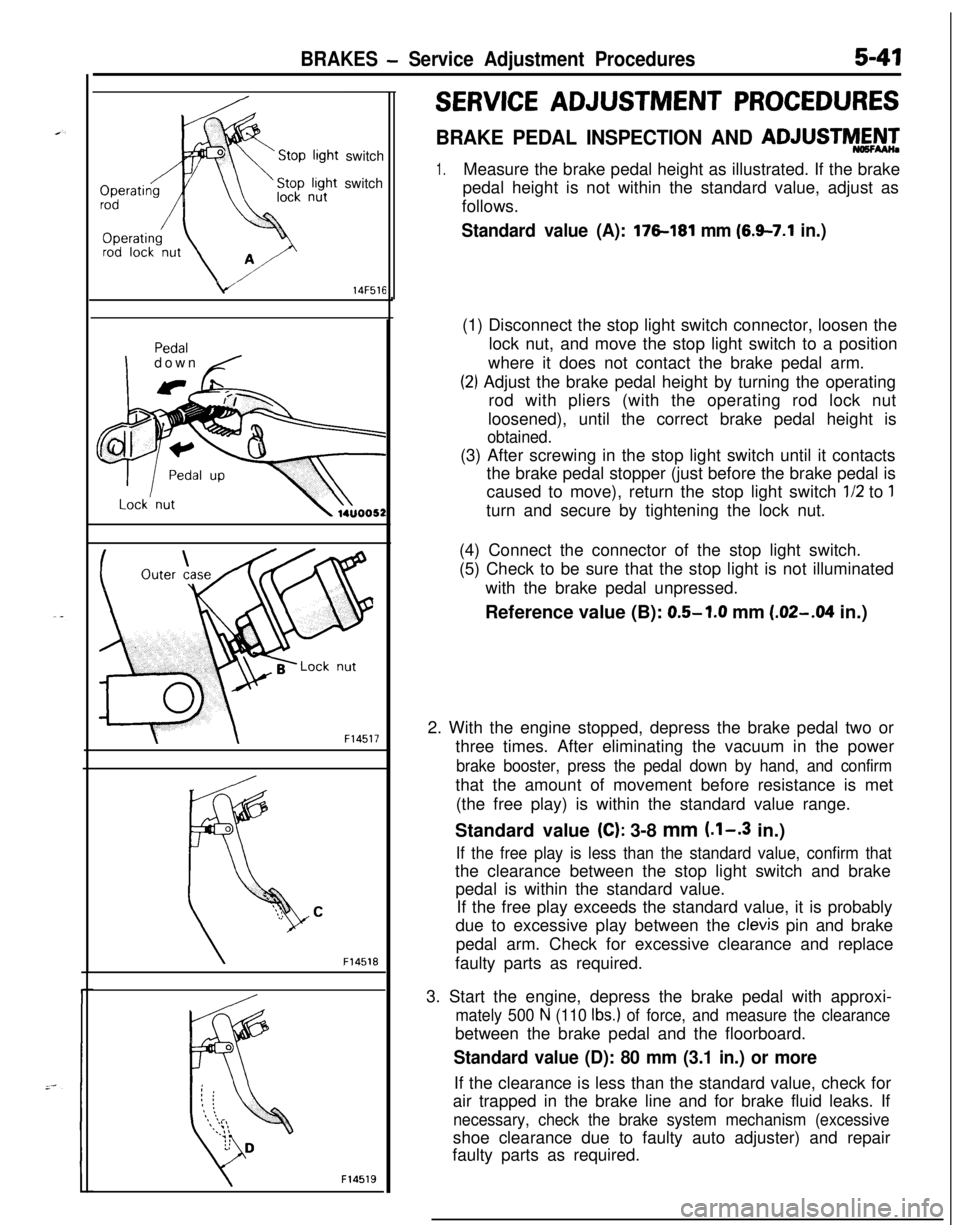
BRAKES - Service Adjustment Procedures5-47switch
switch
v14F516
Idown ,./
F14517
F14518
F14519
SERVICE ADJUSTMENT PROCEDURES
BRAKE PEDAL INSPECTION AND ADJUSTM&g
1.Measure the brake pedal height as illustrated. If the brake
pedal height is not within the standard value, adjust as
follows.
Standard value (A): 176181 mm (6.9-7.1 in.)(1) Disconnect the stop light switch connector, loosen the
lock nut, and move the stop light switch to a position
where it does not contact the brake pedal arm.
(2) Adjust the brake pedal height by turning the operating
rod with pliers (with the operating rod lock nut
loosened), until the correct brake pedal height is
obtained.(3) After screwing in the stop light switch until it contacts
the brake pedal stopper (just before the brake pedal is
caused to move), return the stop light switch
l/2 to 1turn and secure by tightening the lock nut.
(4) Connect the connector of the stop light switch.
(5) Check to be sure that the stop light is not illuminated
with the brake pedal unpressed.
Reference value (B): 0.5-1.0 mm
(.02-M in.)
2. With the engine stopped, depress the brake pedal two or
three times. After eliminating the vacuum in the power
brake booster, press the pedal down by hand, and confirmthat the amount of movement before resistance is met
(the free play) is within the standard value range.
Standard value
(C): 3-8 mm (.l-.3 in.)
If the free play is less than the standard value, confirm thatthe clearance between the stop light switch and brake
pedal is within the standard value.
If the free play exceeds the standard value, it is probably
due to excessive play between the
clevis pin and brake
pedal arm. Check for excessive clearance and replace
faulty parts as required.
3. Start the engine, depress the brake pedal with approxi-
mately 500 N (110 Ibs.) of force, and measure the clearancebetween the brake pedal and the floorboard.
Standard value (D): 80 mm (3.1 in.) or moreIf the clearance is less than the standard value, check for
air trapped in the brake line and for brake fluid leaks. If
necessary, check the brake system mechanism (excessiveshoe clearance due to faulty auto adjuster) and repair
faulty parts as required.
Page 183 of 1216
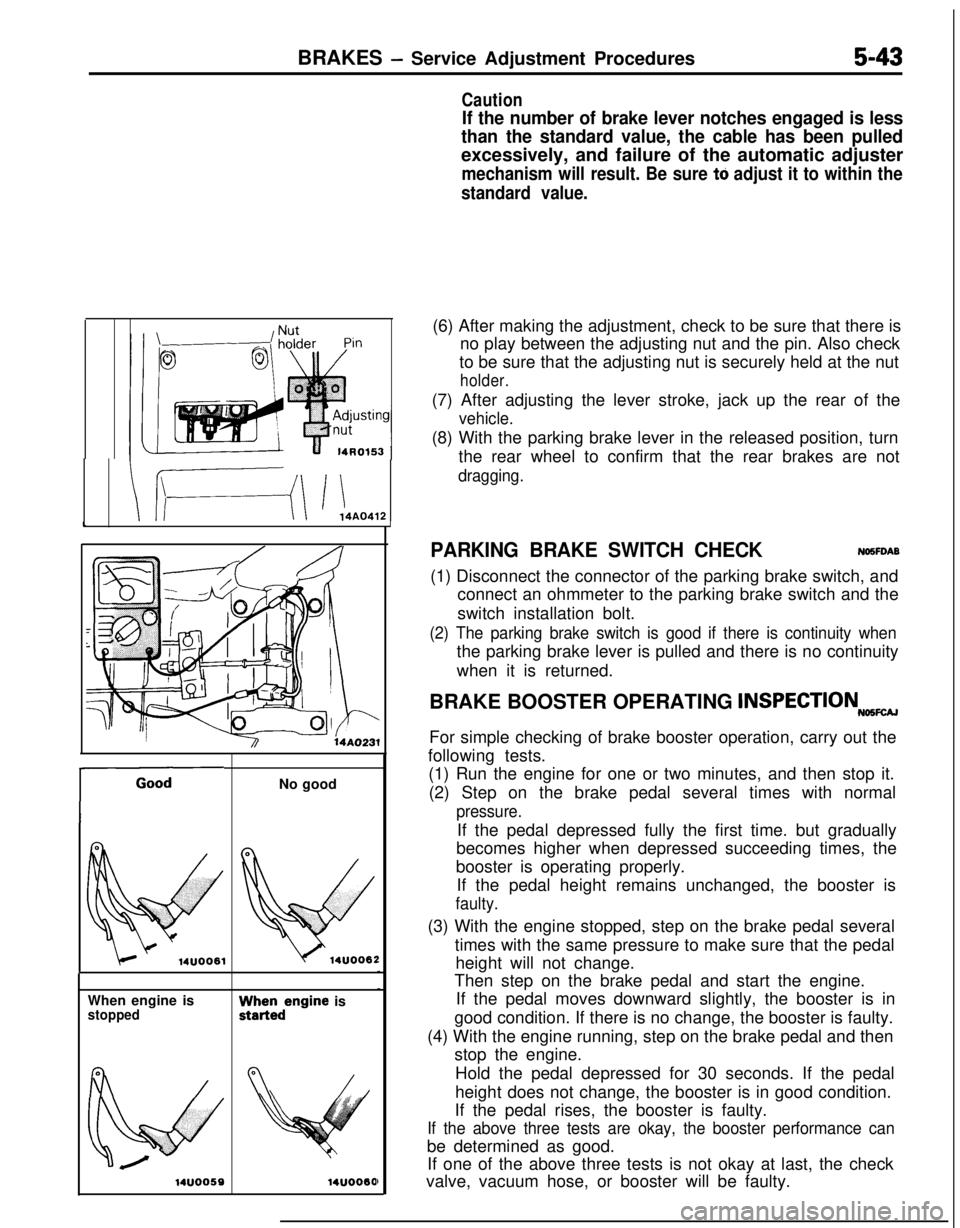
BRAKES - Service Adjustment Procedures5-43When engine is
stoppedNo good
0
wtwo061
VV;Videngine is
t4uoo60
Caution
If the number of brake lever notches engaged is less
than the standard value, the cable has been pulledexcessively, and failure of the automatic adjuster
mechanism will result. Be sure tti adjust it to within the
standard value.(6) After making the adjustment, check to be sure that there is
no play between the adjusting nut and the pin. Also check
to be sure that the adjusting nut is securely held at the nut
holder.(7) After adjusting the lever stroke, jack up the rear of the
vehicle.(8) With the parking brake lever in the released position, turn
the rear wheel to confirm that the rear brakes are not
dragging.
PARKING BRAKE SWITCH CHECKN05FDAB
(1) Disconnect the connector of the parking brake switch, and
connect an ohmmeter to the parking brake switch and the
switch installation bolt.
(2) The parking brake switch is good if there is continuity whenthe parking brake lever is pulled and there is no continuity
when it is returned.
BRAKE BOOSTER OPERATING
lNSPECTIONNoSFcuFor simple checking of brake booster operation, carry out the
following tests.
(1) Run the engine for one or two minutes, and then stop it.
(2) Step on the brake pedal several times with normal
pressure.If the pedal depressed fully the first time. but gradually
becomes higher when depressed succeeding times, the
booster is operating properly.
If the pedal height remains unchanged, the booster is
faulty.(3) With the engine stopped, step on the brake pedal several
times with the same pressure to make sure that the pedal
height will not change.
Then step on the brake pedal and start the engine.
If the pedal moves downward slightly, the booster is in
good condition. If there is no change, the booster is faulty.
(4) With the engine running, step on the brake pedal and then
stop the engine.
Hold the pedal depressed for 30 seconds. If the pedal
height does not change, the booster is in good condition.
If the pedal rises, the booster is faulty.
If the above three tests are okay, the booster performance canbe determined as good.
If one of the above three tests is not okay at last, the check
valve, vacuum hose, or booster will be faulty.
Page 186 of 1216
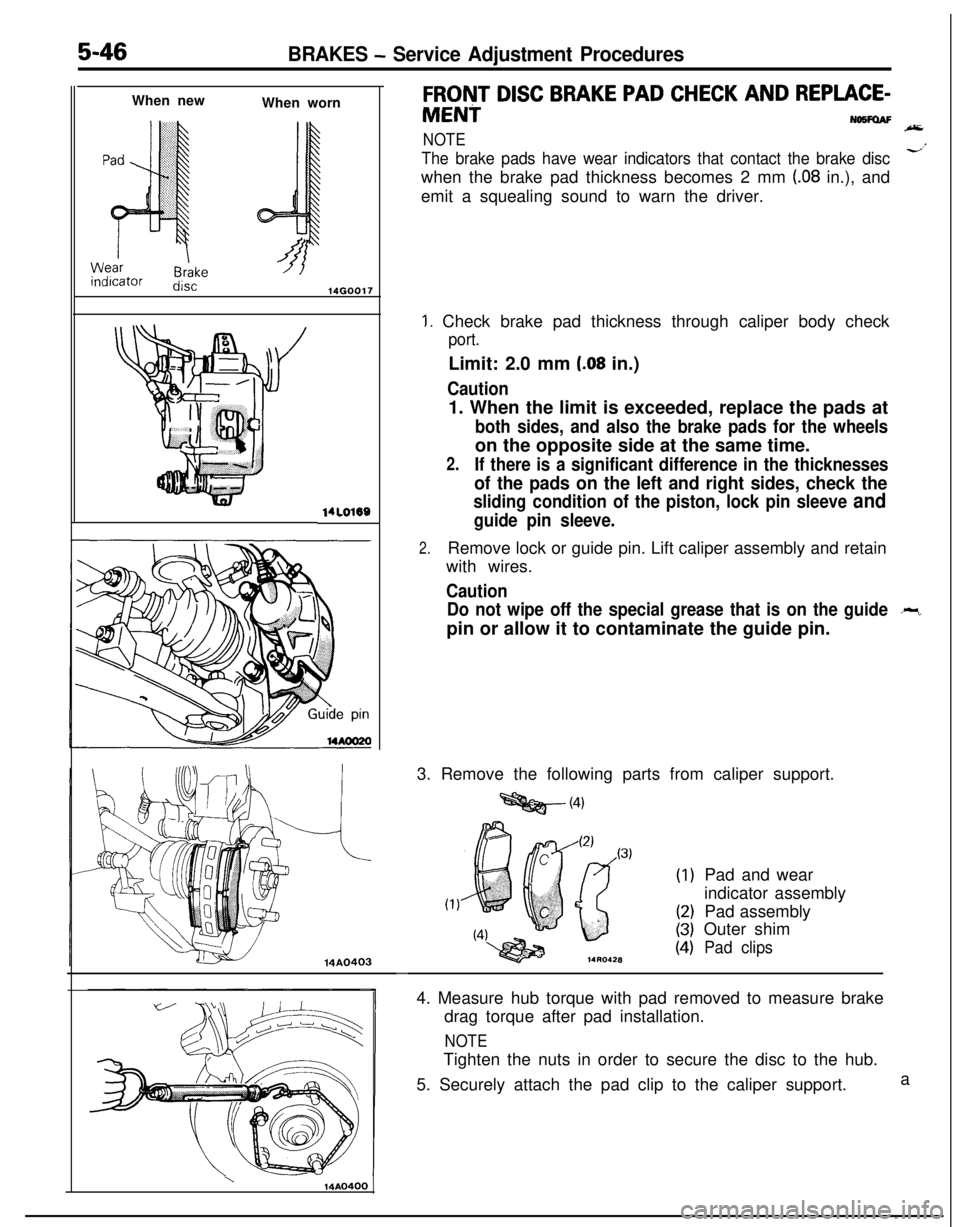
5-46BRAKES - Service Adjustment ProceduresWhen new
When worn
14G0017
14LO169
14A0403
\14AO400
FRONT DISC BRAKE PAD CHECK AND REPLACE-
MENiNWFOAF
NOTE
The brake pads have wear indicators that contact the brake discd’when the brake pad thickness becomes 2 mm
(.08 in.), and
emit a squealing sound to warn the driver.
1. Check brake pad thickness through caliper body check
port.Limit: 2.0 mm
(.08 in.)
Caution1. When the limit is exceeded, replace the pads at
both sides, and also the brake pads for the wheelson the opposite side at the same time.
2.If there is a significant difference in the thicknesses
of the pads on the left and right sides, check the
sliding condition of the piston, lock pin sleeve and
guide pin sleeve.
2.Remove lock or guide pin. Lift caliper assembly and retain
with wires.
Caution
Do not wipe off the special grease that is on the guide
-pin or allow it to contaminate the guide pin.
3. Remove the following parts from caliper support.
=Qg@-(4)
(1)
(2)
(3)
(4)Pad and wear
indicator assembly
Pad assembly
Outer shimPad clips
-4. Measure hub torque with pad removed to measure brake
drag torque after pad installation.
NOTETighten the nuts in order to secure the disc to the hub.
5. Securely attach the pad clip to the caliper support.a
Page 187 of 1216
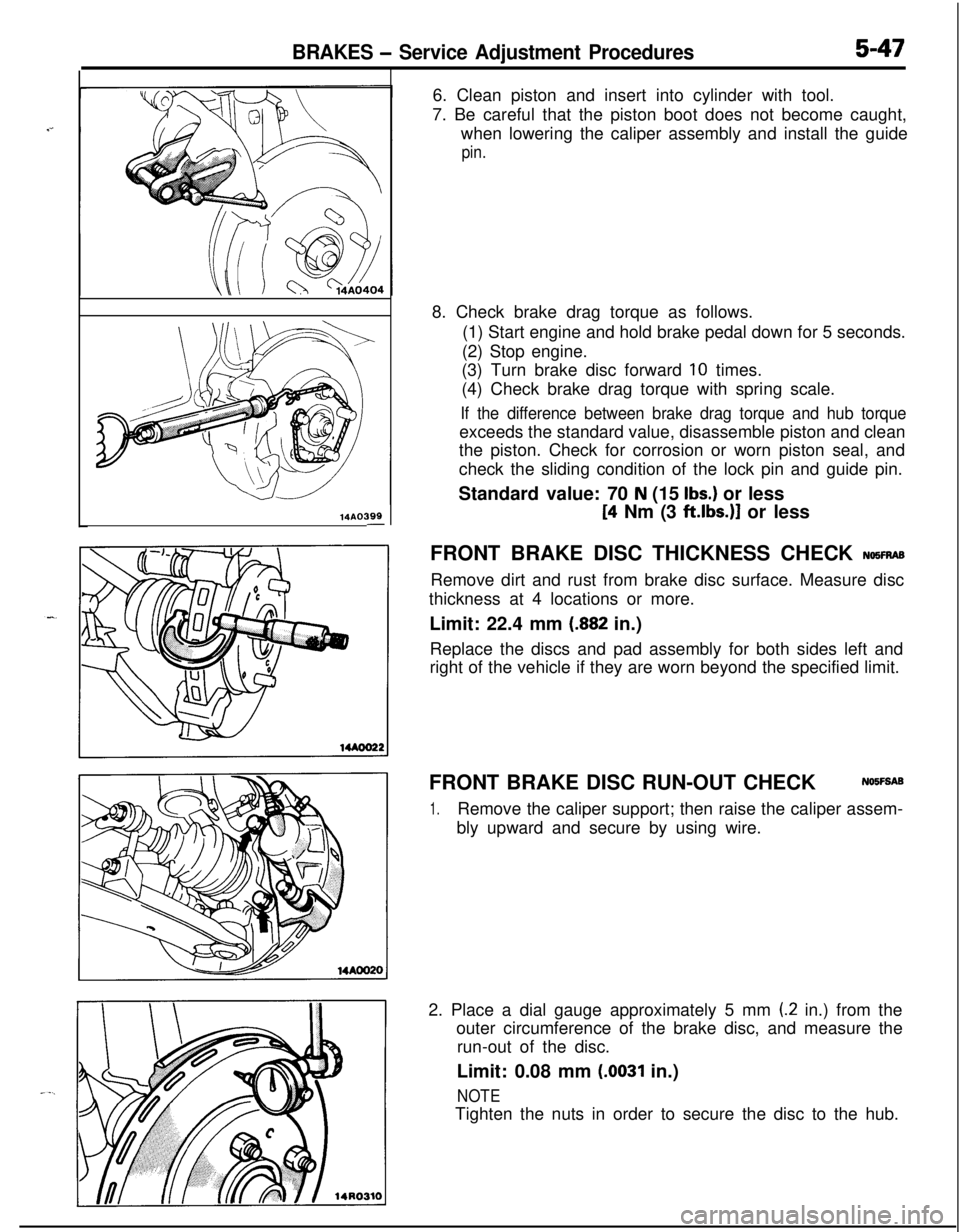
BRAKES - Service Adjustment Procedures5-47
14AO399-6. Clean piston and insert into cylinder with tool.
7. Be careful that the piston boot does not become caught,
when lowering the caliper assembly and install the guide
pin.8. Check brake drag torque as follows.
(1) Start engine and hold brake pedal down for 5 seconds.
(2) Stop engine.
(3) Turn brake disc forward
10 times.
(4) Check brake drag torque with spring scale.
If the difference between brake drag torque and hub torqueexceeds the standard value, disassemble piston and clean
the piston. Check for corrosion or worn piston seal, and
check the sliding condition of the lock pin and guide pin.
Standard value: 70
N (15 Ibs.) or less
[4 Nm (3 ftlbs.)] or less
FRONT BRAKE DISC THICKNESS CHECK
NQ5FRASRemove dirt and rust from brake disc surface. Measure disc
thickness at 4 locations or more.
Limit: 22.4 mm
(.882 in.)
Replace the discs and pad assembly for both sides left and
right of the vehicle if they are worn beyond the specified limit.
FRONT BRAKE DISC RUN-OUT CHECKNOIFSAB
1.Remove the caliper support; then raise the caliper assem-
bly upward and secure by using wire.
2. Place a dial gauge approximately 5 mm
(2 in.) from the
outer circumference of the brake disc, and measure the
run-out of the disc.
Limit: 0.08 mm
(.0031 in.)
NOTETighten the nuts in order to secure the disc to the hub.